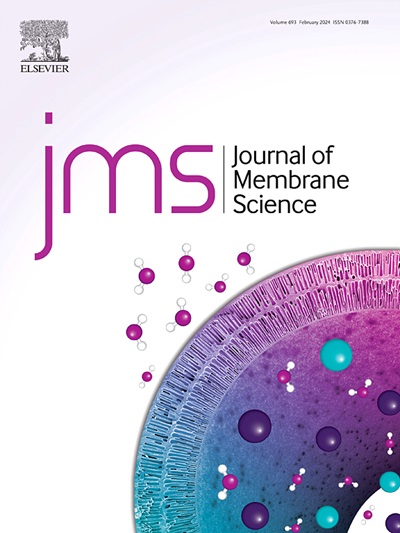In situ symbiosed graphdiyne-based mixed matrix membranes for efficient ethanol recovery
IF 8.4
1区 工程技术
Q1 ENGINEERING, CHEMICAL
引用次数: 0
Abstract
Mixed matrix membranes, which combine the advantages of polymer and inorganic membranes, have attracted significant attention in ethanol-selective pervaporation, but interfacial compatibility and scale-up fabrication remain critical challenges. Here, we propose an innovative “in situ symbiosis” synthesis strategy to directly assemble tris(4-ethynylphenyl) amine-graphdiyne (TPNGDY) in the polymer solution. The wrapping of PDMS chains promotes uniform dispersion of TPNGDY, while the rigid framework of TPNGDY restricts the movement of PDMS chains and mitigates excessive aggregation. This synergistic design not only enhances interfacial compatibility but also optimizes molecular diffusion transport channels, leading to a significant improvement in mass transfer efficiency. The resulting TPNGDY/PDMS MMMs exhibit excellent performance in pervaporation. When separating 5.0 wt% ethanol-water solution at 60 °C, the membranes exhibit an ultra-high flux of 7.42 kg m−2 h−1 and a separation factor of 10.79, corresponding to an 9.76 % increase in flux and a 127.16 % enhancement in selectivity compared to pristine PDMS membranes. Notably, defect-free industrial-scale membranes (1 m × 1 m) were successfully fabricated using a roll-coating approach, which overcomes the limitations of laboratory-scale fabrication. This work provides a practical and feasible solution to addressing filler-polymer interfacial compatibility and large-scale membrane fabrication.

高效乙醇回收的原位共生石墨烯基混合基质膜
混合基质膜结合了聚合物膜和无机膜的优点,在乙醇选择性渗透蒸发中引起了广泛的关注,但界面相容性和规模化制造仍然是关键的挑战。本文提出了一种创新的“原位共生”合成策略,在聚合物溶液中直接组装三(4-乙基苯基)胺-石墨炔(TPNGDY)。PDMS链的包裹促进了TPNGDY的均匀分散,而TPNGDY的刚性框架限制了PDMS链的运动,减轻了过度聚集。这种协同设计不仅增强了界面相容性,而且优化了分子扩散传输通道,从而显著提高了传质效率。所得TPNGDY/PDMS mm具有优异的渗透汽化性能。当在60°C下分离5.0 wt%乙醇水溶液时,该膜表现出7.42 kg m−2 h−1的超高通量和10.79的分离系数,与原始PDMS膜相比,通量增加了9.76%,选择性提高了127.16%。值得注意的是,使用滚涂方法成功地制造了无缺陷的工业规模膜(1 m × 1 m),这克服了实验室规模制造的局限性。这项工作为解决填料-聚合物界面相容性和大规模膜制造提供了一种实用可行的解决方案。
本文章由计算机程序翻译,如有差异,请以英文原文为准。
求助全文
约1分钟内获得全文
求助全文
来源期刊

Journal of Membrane Science
工程技术-高分子科学
CiteScore
17.10
自引率
17.90%
发文量
1031
审稿时长
2.5 months
期刊介绍:
The Journal of Membrane Science is a publication that focuses on membrane systems and is aimed at academic and industrial chemists, chemical engineers, materials scientists, and membranologists. It publishes original research and reviews on various aspects of membrane transport, membrane formation/structure, fouling, module/process design, and processes/applications. The journal primarily focuses on the structure, function, and performance of non-biological membranes but also includes papers that relate to biological membranes. The Journal of Membrane Science publishes Full Text Papers, State-of-the-Art Reviews, Letters to the Editor, and Perspectives.
 求助内容:
求助内容: 应助结果提醒方式:
应助结果提醒方式:


